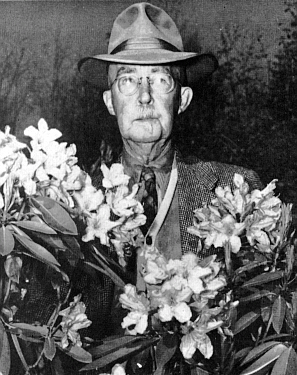QBARS - v15n3 The McKee Rhododendrons
The McKee Rhododendrons
W. D. Christie, Abbotsford, B.C.

|
|---|
Fig. 32. A McKee Hybrid, R. 'Smoky Pink' Christie photo |
Today is the 8th of March and as I look out of my office window I can see grey skies and the bare branches of some big-leaf maples - broken topped from the '55 freeze. Along the edge of the roadway, black looking rain puddles complete the picture of winter gloom.
But it is not winter. True, there was snow over the weekend but 400 feet up the mountainside above the town and overlooking the Fraser. Doctor McKee's rhododendrons are in bloom and in the vase on my desk the rosy pink trusses of this hardy advance guard are proof that the season is underway.

|
|---|
Fig. 35. Dr. C. S. McKee with one of his rhododendron hybrids Christie photo |
Who is Doctor McKee and what are the McKee Rhododendrons? The first question is much easier to answer than the second. The doctor, now 85 years old, is a man of science: a medical doctor who pioneered in the establishment and development of medical diagnostic laboratories and was a leader in this field for many years. A keen plantsman and collector, his interest in rhododendrons began in 1920, at which time he received a large collection of seeds from Edinburgh. This was the beginning of the hobby which has produced the McKee Rhododendrons as they now exist; a miscellaneous collection of plants--good, bad, indifferent and magnificent.
To describe some of these plants is easy. To explain what they are is more difficult. They have no pedigrees and the progress of their development has been more accidental than contrived.
We are told that the original seed sowings included Rhododendron augustinii , californicum , carolinianum , caucasicum , diaprepes , catawbiense , cinnabarinum , decorum , discolor , falconeri , fargesii , fortunei , giganteum , heliolepis , maximum , oreotrephes , pseudoyanthinum , strigillosum , sutchuenense , and thomsonii . No doubt there were others.
These plants were grown in their thousands, originally in Vancouver, and once started, the breeding and selection program was handed over to Mother Nature. Man has interfered very little. No special protection was given to the plants; no artificial crosses were made, and no systematic selection was carried out. Many of the original species had a very short life and after being moved to their present location in 1919 as mostly second or third generation seedlings nature has continued to weed out the weak and the tender. Abbotsford, forty-five miles from the sea often has harsh, cold winters, with temperatures 10 to 15 degrees lower than those at the coast.
The doctor, unlike most of his contemporary rhododendron growers was not really trying to breed or select superior types. He simply liked rhododendrons and in his garden the matronly catawbiense blooms unashamedly among the frilled and perfumed debutantes of the family.

|

|
|---|---|
Fig. 33. McKee rhododendrons growing on side of hill at Abbottsford. Christie photo |
Fig. 34. R. 'McKee Pride' Christie photo |
Ask the doctor and he will tell you that they all have their place and that he just does not have what he would call a poor flower. There are the early pinks which you would expect of R. fargesii and R. oreodoxa and the later scented pinks of R. fortunei and its hybrid progeny. There are also one or two heavy textured, large flowered whites which are truly fine and a few good triflorums. Some are species, some are hybrids and some are just confusing.
You may wonder if we should expect to get anything really outstanding out of a program such as this but there is one point which makes the McKee rhododendrons different. They are the product of 10 years of vigorous natural selection in one of the coldest areas of the Pacific Northwest. Most of them have good foliage. Many of them have good flowers, and they are all hardy. They are good garden plants.
They are in fact the sort of plants which should not be lost and which should not be propagated indiscriminately. They should be evaluated so that the best may be identified and perhaps someday find a place in our gardens. In order to ensure that this is done the Vancouver Chapter has appointed a committee to cooperate with Dr. McKee in making selections.
Whatever the outcome may be, these plants have given much pleasure to many people and to the doctor there will always be the plant that is about to bloom for the first time and may be the best yet.

